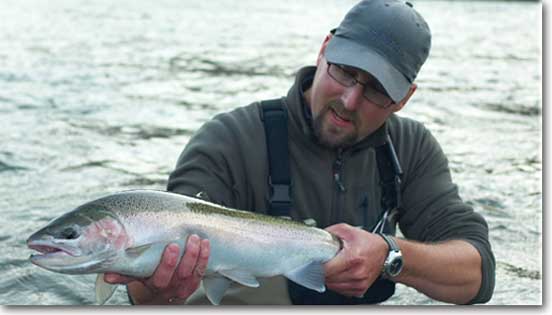By Adam Lapierre
News staff writer
September 10, 2008
Tens of thousands of fall-run salmon and steelhead are currently making the long and strenuous journey from the Pacific Ocean upstream to return to their breeding grounds on the tributaries of the Columbia River, and this season the fish are returning in what could approach record numbers.
Fish are counted on a 24-hour schedule at Bonneville Dam as they pass upstream through the dam’s two fish ladders, and statistics are posted to the Internet on a daily basis through the Oregon Department of Fish and Wildlife Web site at www.dfw.state.or.us.
On Monday, 12,970 chinook, 7,970 steelhead and 4,612 coho salmon passed through the ladder, indicating the fall run is very strong this year. A year ago, from Aug. 8 to Sept. 8, 2007, 98,680 chinooks were counted. This year during the same month period 225,651 chinook passed through the fish ladders at Bonneville.
John Dalen, Army Corps of Engineers fish biologist, attributes several factors to the high numbers, but is cautious about saying that the fish have made a big ‘comeback’ after the slow decline in numbers in recent decades.
“This fall run is looking very strong,” Dalen said. “I think we are headed for a really good year; maybe even a record year if the numbers continue like this.
“Last year was pretty typical of what we have been seeing over the last two decades, which is the slow decline that we have been fighting. I think this year is going to change the way some people think about what is going on in the river,” he said. “Some people are going to say that we have turned a corner … and if these numbers keep up, maybe we have.”
Lower river temperatures and a lower-than-average peak river temperature are two reasons the fall run has been so big thus far (currently almost 200,000 adult chinook), according to Dale.
This summer the river temperature peaked at 72 degrees from Aug. 17-21, which is a few degrees cooler than the average peak. The fall run salmon and steelhead generally make their big pushes upstream once the water cools down after the warmest part of the summer, but this year they started earlier and have continued running strong.

“The sockeye run has also been incredible this year,” Dalen continued. “There have only been two years where we have seen more sockeye, and they were both in the 1950s.”
The fall run generally continues through the end of September, which means hundreds of thousands more fish are expected to pass through the dam before the season fades out. This is good news to fishermen who line the riverbanks and mouths each season hoping to hook into a 30-plus-pound chinook.
“This should definitely be a great fall for fishing,” Dalen added.
For the commercial fisheries on the Oregon and Washington coast, current restrictions remain in place, which means that this year there is no chinook salmon fishing of any kind south of Cape Falcon. The ban on chinook retention this year likely had little effect on the Columbia River salmon, however.
“The commercial bans that were put into effect this year on the Oregon coast should have little to do with what is going on in the Columbia,” said Eric Schindler, of the Oregon Department of Fish and Wildlife. “All the salmon within the banned area are heading south, not toward the Columbia.”
Currently restrictions, not bans, are in place for the waters surrounding the mouth of the Columbia, from Ledbetter Point in Washington and Cape Falcon in Oregon.
“Some of this strong run may have resulted from the restrictions that have been made,” Dalen said. “But the broadness of the different species and runs that we are seeing improvements in means there are definitely other factors. Hopefully this is a result of all the work people have been doing over the years in many different areas, and hopefully this will continue.”
Article from Hood River News.com
 ...In our opinion, they are the best of the best. We are not a booking agent, but simply a resource for you to find a reputable fly fishing guide...
...In our opinion, they are the best of the best. We are not a booking agent, but simply a resource for you to find a reputable fly fishing guide...
 ...In our opinion, they are the best of the best. We are not a booking agent, but simply a resource for you to find a reputable fly fishing guide...
...In our opinion, they are the best of the best. We are not a booking agent, but simply a resource for you to find a reputable fly fishing guide...
 "Reading my book," she replies, thinking isn't that obvious?
"Reading my book," she replies, thinking isn't that obvious? 
